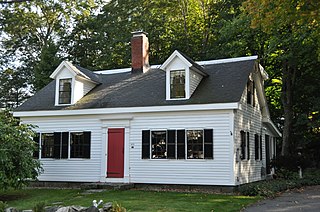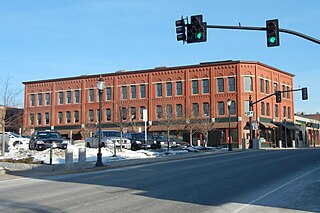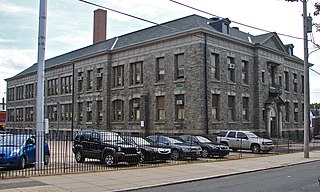
Mount Airy station is a SEPTA Regional Rail station at 119 East Gowen Avenue between Devon and Sprague Streets, Philadelphia, Pennsylvania. The station building is listed on the National Register of Historic Places and was built in 1875 with Frank Furness as the likely architect, according to the Philadelphia Architects and Buildings project. The National Register of Historic Places Nomination Form lists the architect as unknown, but notes the similarities to the nearby Gravers station which was designed by Furness. Both stations display an aggressively styled roofline in the Queen Anne Stick Style. The Mount Airy station's roof is described as "combining hipped, gabled, jerkinhead designs with a double splayed profile" and the Graver's Lane Station might be considered even more aggressive.

Wycombe is an unincorporated community mainly in Wrightstown Township but also in Buckingham Township, Bucks County, Pennsylvania, United States. Founded in the 1890s when the Northeast Pennsylvania Railroad opened a line through the county, it was called "Lingohocken" by local residents, but the post office was named "Wycombe" to prevent confusion with the post office in Wingohocken. The Lingohocken Fire Company, located on the edge of town, retains this older name. The New Hope and Ivyland Railroad still owns the rail line through the town, and, having finished restoring the former Reading Company station building in 2011, intends to restore service through Wycombe. They also store some of their original passenger cars last used in the 1970s adjacent to the station.

Washington Firehouse No. 5, also known as Fire Station No. 5, is a historic fire station in Mobile, Alabama, United States. The two-story brick Greek Revival building was built in 1851 at a cost of $5,500. It was constructed to house the privately run Washington Fire Company. The building features a Doric distyle-in-antis arrangement at the street level supporting an upper story with jib windows opening onto a cantilevered iron balcony. The building was documented by the Historic American Buildings Survey in 1936 and was added to the National Register of Historic Places on December 22, 1983.

The Harnden–Browne House is a historic house at 60-62 Salem Street in Reading, Massachusetts, exemplifying the adaptation of older buildings to new architectural styles. The 2 1⁄2-story wood-frame house was built in 1831 by Sylvester Harnden, likely in a Georgian-Federal vernacular style. Later in the 19th century it was restyled with some Queen Anne details, and converted to a boarding house. In 1928 it was owned by Thomas Browne, an Irish immigrant who first roomed in the house.

The House at 483 Summer Avenue in Reading, Massachusetts, USA, is a modestly decorated vernacular Federal style cottage. The 1-1/2 story wood frame house was built c. 1830, late for a Federal style building. Its significant Federal features are its five-bay facade, side-gable roof, and the door surround, which has pilasters supporting a tall entablature with a projecting cornice. The house is finished in wooden clapboards, and has two gabled dormers projecting from the front roof.

The Mark Temple House is a historic house in Reading, Massachusetts. The 2 1⁄2-story timber-frame house was built c. 1753 by Jonathan Temple, whose family lived all along Summer Street. In the 1850s "Uncle Mark" Temple, remodeled the Georgian style house into the Greek Revival style then still popular in Reading. Among his changes was to turn the original building 90 degrees and raise its foundation. Oscar Foote, a locally prominent real estate developer and businessman, bought the house in 1863.

The Masonic Block is an historic commercial block in Reading, Massachusetts. This three story brick building is distinctive in the town for its Renaissance Revival styling. It was built in 1894 by the local Reading Masonic Temple Corporation, and housed the local Masonic lodge on the third floor. The building was listed on the National Register of Historic Places in 1984.

The Old Hose House is a historic fire house in Reading, Massachusetts. The Colonial Revival wood frame building was constructed in 1902 for a cost of $1,180.50, plus $10 for the land on which it stands. The modestly-scaled building housed a fire truck until 1930, after which time it has served as home to community groups. The building was listed on the National Register of Historic Places in 1984.

The Reading Municipal Light and Power Station is a historic municipal power station building at 226 Ash Street in Reading, Massachusetts. The single story brick building was built in 1894 after the town decided to build a municipal power station. The Romanesque style building was designed by George E. Abbott, and housed power generating equipment until 1925, when it was converted to housing power switching equipment. It now houses municipal offices.

The Roberts House is a historic house at 59 Prospect Street in Reading, Massachusetts. The two-story house is basically Colonial Revival in character, but also exhibits Craftsman style features, including extended eaves with exposed rafter ends, stucco walls, and a chunky entrance portico. The window above the entrance is a Shingle style band of three casement windows, and there is a hip-roof dormer in the roof above. The house is one of Reading's better examples of Craftsman architecture, and was built in 1911, during a building boom on the town's west side.

Tamaqua is disused railway station located in the Tamaqua Historic District, Schuylkill County, Pennsylvania, United States. It was originally constructed by the Philadelphia and Reading Railroad in 1874, which had earlier acquired the Little Schuylkill Navigation Railroad and Coal Company. It is a one-story brick building in the Italianate style. An addition was made to the original 1874 building in 1880, giving it a "T-plan." In 1885, a freight house was added.

The Quakertown Passenger and Freight Station is a historic train station and freight depot located at Quakertown, Bucks County, Pennsylvania. The two buildings were designed by Wilson Bros. & Company in 1889 and built by Cramp and Co. for the Philadelphia and Reading Railroad in 1902. The passenger station is constructed of dark Rockhill granite and Indiana limestone and is in a Late Victorian style. It is 1 1/2 stories tall and measures 25 feet wide by 97 feet, 6 inches, long. It has a hipped roof with an eight-foot overhang. The freight station is a 1 1/2-story, rectangular stone block building measuring 128 feet by 30 feet. Also on the property is a large crane that was used for freight movement. The Quakertown station had passenger rail service along the Bethlehem Line to Bethlehem and Philadelphia until July 27, 1981, when SEPTA ended service on all its intercity diesel-powered lines. SEPTA still owns the line and leases it to the East Penn Railroad. Other towns, stations, and landmarks on the Bethlehem Line are Perkasie, Pennsylvania, Perkasie Tunnel, and Perkasie station.

Hampden Firehouse is a historic fire station located at Reading, Berks County, Pennsylvania. It was built in 1887, and is a two-story, brick building on a granite foundation in the Renaissance Revival style. It was designed by noted Philadelphia architect Edwin Forrest Durang. It features a double pedimented roof influenced by the Greek Revival style and round arched windows.

Keystone Hook and Ladder Company is a historic fire station located at Reading, Berks County, Pennsylvania. It was built in 1886–1887, and is a two-story, brick building in the Queen Anne style. A two-story annex was added in 1888 or 1890. The front facade features a wooden bell tower with a pyramidal roof.

Lebanon is a historic railway station located in Lebanon, Lebanon County, Pennsylvania. It was designed by George Watson Hewitt and built in 1885, by the Cornwall & Lebanon Railroad. The building was expanded in 1912. It is a two-story, brick, brownstone, and terra cotta building in an eclectic Victorian style reflecting 17th-century Flemish, Romanesque, and Chateauesque influences. It features a broad porch roof with ornamental iron brackets. The Cornwall & Lebanon Railroad opened in 1883, and was acquired by the Pennsylvania Railroad in 1918.

Olney Elementary School is a historic elementary school located in the Olney neighborhood of Philadelphia, Pennsylvania. It is part of the School District of Philadelphia. The building built in 1900–1901 and is a two-story ashlar and smooth limestone building in the Georgian Revival-style. It features a projecting pedimented center bay and arched limestone entrance surround.

Politz Hebrew Academy, formerly known as William C. Jacobs School and Fayette School, is a historic school located in the Bustleton neighborhood of Philadelphia, Pennsylvania. The building consists of an original section designed by Samuel Sloan in 1855, and the main building built in 1915. The original building is a two-story, stone building sheathed in stucco. The 1915 building is a 2 1⁄2-story, three-bay, rectangular brick building in the Colonial Revival style. It features a hipped roof and gable dormers.

David Landreth School is a historic school building located in the Point Breeze neighborhood of Philadelphia, Pennsylvania. It was built in 1889 after the original school caught fire.

St. Anthony de Padua Parish School is a historic Catholic school building located in the Southwest Center City neighborhood of Philadelphia, Pennsylvania. It was built in 1897, and is a four-story, red brick building with stone trim in the Romanesque Revival-style. It has rounded arched window openings, a hipped roof with dormer, and freestanding brick fire tower.

Metropolitan Edison Building is a historic office building located at Reading, Berks County, Pennsylvania. It was built in 1926–1927, and is a 12-story, "L"-shaped, steel frame building faced with Indiana limestone, brick, and terra cotta reflective of the Chicago style. It stands 150 feet tall. A five-story addition was completed in 1956. The building measures 119 feet, 8 inches, by 169 feet, 6 inches. It was the original home of the Metropolitan Edison Company, Gilbert-Commonwealth, and the CNA Insurance Company.
























